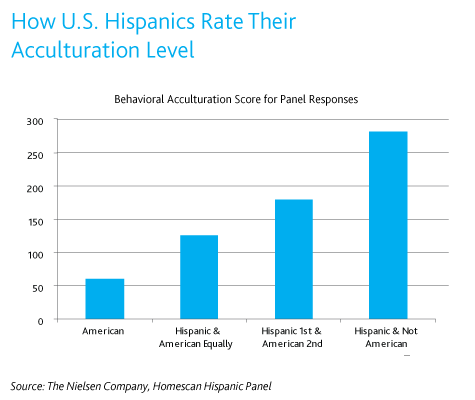
Doug Anderson, SVP, Research & Development, The Nielsen Company
SUMMARY: The U.S. added nearly 1.2 million persons of Hispanic origin to the population between 2007 and 2008, raising the Hispanic population from 15.1% to 15.4%. And new Hispanic immigrants are expected to continue to come in large numbers for the foreseeable future. Since a large share of the Hispanic population in the U.S. will continue to be new immigrants and their second generation children, the acculturation process may not happen has quickly or as thoroughly as with past immigrant groups. Marketers need to be acutely aware of both language and acculturation matters when crafting marketing strategies.
Marketers looking to tap into high-growth population segments should turn their attention to the U.S. Hispanic segment, which grew at a rate 3.4 times higher than the total population between 2007 and 2008 and nearly ten times higher than the non-Hispanic white population. Over half of all U.S. population growth during this time came from Hispanics, raising Hispanics to 15.4% of total U.S. population—a year-over-year growth rate of more than 2.6%.
Continued growth
In fact, that trend is expected to continue. Projections show the Hispanic population will reach nearly 20% by 2020 and over 30% by 2050—making Hispanics no longer a niche market, but a mainstream one. And unlike immigrant populations from the first part of the 20th century—when immigration laws stopped the inflow of people from countries such as Italy, Ireland and Poland—new Hispanic immigrants are expected to continue to come in large numbers for the foreseeable future, making the acculturation process much slower than it was for previous generations.
For marketers, careful attention around both language and acculturation are essential to success. While these concepts are closely related, they are quite different. Language may be necessary for acculturation, but even Hispanics with excellent English-language skills may still respond more favorably to advertising that is in the Spanish language or messaging that shows various aspects of Hispanic culture. Marketers must shift their focus from thinking about whether Hispanics can understand their advertising to creating campaigns that speak to the heart of the Hispanic consumer in the U.S.
Language and acculturation
To accurately understand acculturation matters, language and acculturation need to be analyzed separately in ways that can be applied across categories and geographies so the purchasing behavior of both Hispanics and non-Hispanics can be compared and contrasted. Nielsen has created a measure of behavioral acculturation that tracks purchase data across nearly 700 different categories to determine how similar the purchases of Hispanic households are to the purchases of non-Hispanic households with the same overall demographic characteristics. Hispanic households are considered “behaviorally acculturated” when purchasing patterns match the behavior of non-Hispanic households.
The chart below shows the index of the behavioral acculturation measure for U.S. Hispanics with varying language preferences. A low index shows high acculturation—purchasing behavior is similar for Hispanic and non-Hispanic households. The higher the index, the more dissimilar Hispanic behavior is as compared to non-Hispanic behavior and the more behaviorally unacculturated the segment is. Not surprisingly, households that only speak Spanish are the least behaviorally acculturated.

Additionally, when U.S. Hispanic members of the Nielsen Homescan Hispanic Panel were asked to rate their personal level of acculturation, those who defined themselves as following only Hispanic or Latino culture purchased products very differently from demographically similar non-Hispanics. In this survey, the word “American” refers specifically to United States culture.

Other predictors of behavioral acculturation include:
- Length of time in the U.S.—recent immigrants are the least behaviorally acculturated, while those who have been in the U.S. for more than 20 years are just as behaviorally acculturated as those born in the U.S.
- Language at home—those who speak Spanish at home are less behaviorally acculturated than those who commonly speak English, but even those who prefer to use Spanish at home are more behaviorally acculturated than those who only speak Spanish. For many Hispanic households who speak English well, but still use Spanish at home, Spanish-language advertising may resonate better.
- Relationships—those whose friends are also Hispanic are less behaviorally acculturated than those with mainly or solely non-Hispanic friends.
- Education—those with higher levels of education are more behaviorally acculturated than those with lower levels.
Closing the gap
The income distribution of Hispanics compared to the non-Hispanic population of the U.S. is marked by large gaps at the top end of the income spectrum. While Hispanics are more concentrated in the lower annual income ranges below $50k, there is parity between Hispanic and non-Hispanic households in the $50-75k annual income range.

Levels of educational attainment also lag for Hispanics in the U.S., but there is evidence among younger Hispanics that these levels might change substantially in the future. According to the Pew Hispanic Center, 86% of Hispanics between the ages of 16 and 25 are either in school or in the labor force—both skill-building activities that will pay dividends in income further down the road. Overall, Hispanics are nearly four times more likely to have no high school (9th grade or less), and over two times more likely than average to have dropped out of high school.
And while the incidence of advanced college degrees for Hispanics is 60% below the national norm, this level has been on the increase for decades—driven substantially by changes in the behaviors of young Hispanic women. In 1980, 35% of Hispanic women between the ages of 16 and 25 were in school (with 40% of those in school and working). By 2007, this level had increased to 50%. There has also been a marked decline in early pregnancy among young Hispanic women—24% were not in school or the labor force and were mothers in 1970. By 2007, only 9% had the same status. Young Hispanic men have also seen increases in the percentage in school, but not nearly to the degree as for women.
When it comes to education, the intent of Hispanic youths is often sidetracked by economic realities. According to the Pew Hispanic Center, nearly 90% of Hispanics between the ages of 16 and 25 believe that a college education is important to success in life—versus 74% of the general public. That sentiment is echoed by parents with more than three-quarters agreeing that college is the most important thing to do after high school. However, just under half of Hispanics plan to get a college degree versus 60% of the total population in the same age ranges.
Much of this gap can be explained by differences between U.S.-born Hispanics and the foreign-born young Hispanics who make up around one-third of this age cohort. Less than half of foreign-born Hispanics plan to go to college—often citing the need to work to support family either in the U.S. or in their native countries. Nearly two-thirds of foreign-born Hispanics sent money to family in their native countries versus 21% for those born in the U.S. And a much higher share of foreign-born young Hispanic women are mothers—29% versus 17% for U.S.-born Hispanic women.

Seize the moment now
The pace of Hispanic acculturation in the U.S. will depend on many factors. However, it will likely never mirror the same assimilation patterns of immigrants from past generations. The ready availability of Spanish media (television, radio, newspapers, websites, etc.) and the easy ability to communicate with friends and family who have not come to the U.S. slows the pace of acculturation, as does the continuing influx of new immigrants who reinforce the native cultural experience in Hispanic communities. Unlike immigrants from earlier in the history of the U.S., Hispanics today can participate in society while still retaining strong aspects of their Latino culture—including a preference for speaking Spanish at home or with their families and friends.
While Hispanics will become more acculturated over time and over generations—particularly in their purchasing behavior—they are not likely to leave their Latino culture behind. Marketers who wait around for Hispanics to acculturate rather than actively reaching out to this growing market now will be left waiting.
Sources:
The Nielsen Company, Homescan Hispanic Panel
Pew Hispanic Center—Latinos and Education: Explaining the Attainment Gap (October, 2009)
Pew Hispanic Center—The Changing Pathways of Hispanic Youths Into Adulthood (October, 2009)
U.S. Census Bureau Current Population Survey Annual Social and Economic Supplement 2008 (released September 2009)



